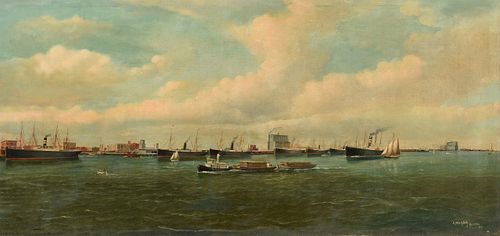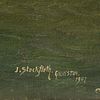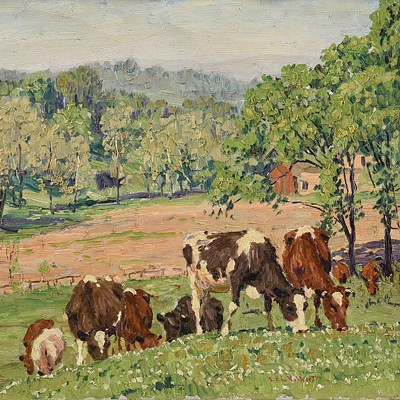JULIUS STOCKFLETH (American/Texas 1857-1935) A PAINTING, "View of Galveston from Pelican Island," 1907,
About Seller
6116 Skyline Drive, Suite 1
Houston, TX 77057
United States
Simpson Galleries has been serving Houston’s need for the very best in antique sales venues for more than fifty years. Beginning in 1962, William Simpson started educating himself and others in the art of collecting fine antiques and art objects. Simpson Galleries' commitment to excellence and accur...Read more
Two ways to bid:
- Leave a max absentee bid and the platform will bid on your behalf up to your maximum bid during the live auction.
- Bid live during the auction and your bids will be submitted real-time to the auctioneer.
Bid Increments
| Price | Bid Increment |
|---|---|
| $0 | $25 |
| $500 | $50 |
| $1,000 | $100 |
| $2,000 | $250 |
| $5,000 | $500 |
| $10,000 | $1,000 |
| $20,000 | $2,500 |
| $50,000 | $5,000 |
| $100,000 | $10,000 |
| $200,000 | $25,000 |
About Auction
Feb 16, 2020
Including important Maps, Audubon Havell prints; works by artists Lee N. Smith, Billy Hassell, Frank Reaugh, Porfirio Salinas, Richard MacDonald, Tsing-Fang Chen, Charles Schorre, Leroy Neiman, and Arman; and a painting by the fourth man to walk on the moon, Alan Bean. Simpson Galleries online_auctions@simpsongalleries.com
- Lot Description
JULIUS STOCKFLETH (American/Texas 1857-1935) A PAINTING, "View of Galveston from Pelican Island," 1907, oil on canvas mounted to board, signed, placed and dated L/R, "J. Stockfleth, Galveston, 1907." 23 3/4" x 50" Note: A sweeping panorama view south from Pelican Island of steamboats, trawlers, tugboats moving through the Port of Galveston in a serene seascape; the skyline of the Strand sprouts in the background. The W. L. Moody Co. Building in view at left was constructed in 1884. Cumulus clouds blow in north of the Gulf Coast.Julius Stockfleth was born on January 29. 1857 in Wyk auf Föhr in Schleswig-Holstein, Germany. Stockfleth’s early artistic training began where he apprenticed to a local painter in Wyk. He emigrated to the United States in 1883, making a home in Galveston in 1885. No previous artist left as complete a picture of Galveston and western Gulf Coast shipping as did Stockfleth. Of particular historical interest was the series of paintings, some of which survive only in postcard reproductions that documented the hurricane of September 8, 1900, which devastated Galveston and took more than 6,000 lives. Stockfleth continued to paint scenes of Galveston at the turn of the century. His are the only known contemporary paintings of Galveston before, during, and after the hurricane and the subsequent rebuilding. Altogether, Stockfleth left some 200 paintings of Texas subjects painted in a naïve realist style.He returned to Germany in 1907, living in Wyk painting local scenes until his death. His paintings, drawings, and watercolors can be found in private collections and museums worldwide.This painting was painted during the last year that Stockfleth lived in Texas before returning to Germany. The size of the painting and attention to detail pronounce the importance of Galveston Harbor as a bustling shipping port. The tug boat in the middle foreground shown hauling barges of cotton almost as a tribute to the W.L. Moody and Co. whose name is displayed prominently on the building to the left side of the wharf.Moody's business activities centered on his cotton and banking interests in Galveston under the auspices of his firm, W. L. Moody and Company. The firm handled a substantial portion of the cotton business in Texas. In 1894 it built the first dockside cotton compress in Texas.By 1899 Galveston was the world's foremost cotton port and the fifth most important port in the United States. Innovative ideas like the high-density compression of cotton developed at Galveston kept the wharves competitive. In 1900 exports from Galveston were valued at more than $85 million. The present painting is newly discovered and one of the most comprehensive compositions of Galveston's importance as a seaport and will be included in the upcoming catalogue raisonné of works by Julius Stocklfleth, currently compiled by William Simpson, Sr. A related painting of similar subject and date is illustrated in the 1976 book "Julius Stockfleth; Gulf Coast Marine and Landscape Painter" by James Patrick McGuire on page 40, illustration #12 - noted as part of the collection of the Rosenberg Library, Galveston, Texas. Provenance: Property donated and sold to benefit the Makaha Community Center of Hawaii - dedicated to improving the lives of local homeless and underprivileged children.A few minor losses near minor frame rubbing with some stain transfer, recently lightly cleaned, overall in good to very good condition, wear commensurate with age. Simpson Galleries strongly encourages in-person inspection of items by the bidder. Statements by Simpson Galleries regarding the condition of objects are for guidance only and should not be relied upon as statements of fact and do not constitute a representation, warranty, or assumption of liability by Simpson Galleries. All lots offered are sold "AS IS."
Condition
- Shipping Info
-
**SIMPSON GALLERIES, LLC. DOES NOT PROVIDE SHIPPING SERVICES OR SHIPPING QUOTES.** Shipping may be secured through - The UPS Store: auctions@epicpartnershipco.com 281-764-9551, The UPS Store: store3229@theupsstore.com 713-334-8869, PACK-N-SEND: sales@pack-n-send.com 713-266-1450, ACTS Crating and Transportation Services: crating@actsintl.com 713-869-2269, NAVIS Pack & Ship: 17013tx@gonavis.com 713-352-3038, Wintersteen Trucking: wintersteentrucking@yahoo.com 800-253-0617, or the shipper of your choice.
-
- Buyer's Premium



 EUR
EUR CAD
CAD AUD
AUD GBP
GBP MXN
MXN HKD
HKD CNY
CNY MYR
MYR SEK
SEK SGD
SGD CHF
CHF THB
THB



























